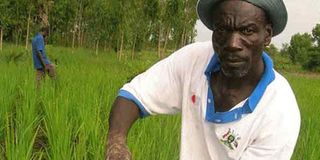How Uganda's use of farm machines feed Kenya

Mr Julius Okello Awany, a farmer in Uganda, fixes a nozzle of the sprinkler irrigation pump. PHOTO | FILE | NATION MEDIA GROUP
What you need to know:
The adoption of hybrid varieties of maize seed has greatly boosted yields
The country’s success is partly due to its research institutions, which work with the private sector to deliver agricultural technologies to farmers at the grassroots.
- Massive awareness creation has also led many farmers to embrace best agronomical practices, from land tilling to post-harvest management.
KAMPALA. With mild temperatures and two rainy seasons in most parts of the country that allow for multiple crop harvests, investors consider Uganda’s agricultural potential among the best in Africa.
So smitten by the land was Winston Churchill that he named it the Pearl of Africa.
A 2019 publication by the US-based Export.Gov, which quotes figures from the UN’s Food and Agriculture Organisation (FAO), says Uganda has the potential to feed 200 million people.
The report notes that more than 80 per cent of the country’s land is arable, but only 35 per cent is under cultivation.
Uganda produces a wide range of foods including coffee, tea, sugar, livestock, poultry, palm oil, simsim, groundnuts, cotton, tobacco, bananas, maize, beans, cassava, sweet potatoes, Irish potatoes, millet, sorghum, cocoa, fruits and vegetables.
But it is not just the country’s climate that gives it a head start in the region’s food production race. National Crops Resources Research Institute (NaCRRI) Director Geoffrey Asea, a maize breeder, attributes part of the country’s success to strong research systems.
He says research institutions work with the private sector to deliver agricultural technologies to farmers at the grassroots level.
The seed systems for all crops are well catered for by over 40 certified companies. Most of them grow maize and process seed for the farmers. There are also various processors across the country.
AVERAGE YIELD
Dr Asea says 1.2 million hectares is under maize, and that the adoption of hybrid varieties by more farmers pushed the average yield to 3.5 tonnes per hectare in 2018, up from 2 tonnes in 2017.
Bank of Uganda statistics, he noted, show that maize exports totalled $95.91 million (about Sh9.6 billion) in 2017, and $106 million (Sh10.7 billion) in 2018, while beans brought in $99 million (Sh9 billion), up from $84 million (Sh8.4 billion) over the same period.
Total exports to Kenya stood at $719 million (Sh72.6 billion) by the end of last year, compared with $551.06 million (Sh55.6 billion) recorded in 2017 with maize topping the exports.
Besides maize and beans, Uganda exported simsim, pineapples, watermelons and eggs to Kenya in the second half of 2018. Simsim exports rose from $17.3 million (Sh1.7 billion) in 2017 to $26.6 million (Sh2.7 billion) in 2018.
Some maize is processed flour that the World Food Programme (WFP) exports as relief food to various countries in the region.
Another contributor to increased maize exports to Kenya is growth in large-scale mechanised farms that have boosted production. A number of these farmers are based in Uganda’s fertile north.
Dr Asea also notes that massive awareness creation has led many farmers to embrace best agronomical practices, from land tilling to post-harvest management.
MORE FISH
Many policies in Uganda also favour agriculture. One, Operation Wealth, is a controversial initiative through which government gives free fertiliser, seeds and seedlings to needy farmers.
Controlling the fall armyworm, reducing post-harvest losses and greater use of fertilisers are expected to boost yields even more.
Beyond production, Uganda also releases a lot of its maize for export and poultry farming because of its diversified food menu.
Poultry farming in Uganda is highly productive and cost-effective for a number of reasons.
Mbarara Zonal Agricultural Research and Development Institute Director Halid Kirunda says Uganda’s cost of labour in poultry keeping is lower than Kenya’s. This is because poultry feeds, such as maize bran, are derived from maize, which is produced in large volumes.
There are other feeds such as sunflower cake, soybean cake and silver fish. Large volumes of fish are obtained from Lake Victoria. Uganda has a bigger portion of fish than Kenya.
Final instalment tomorrow: How Kenya’s land prices, which are higher than those in some parts of the US, are ruining livelihoods.




